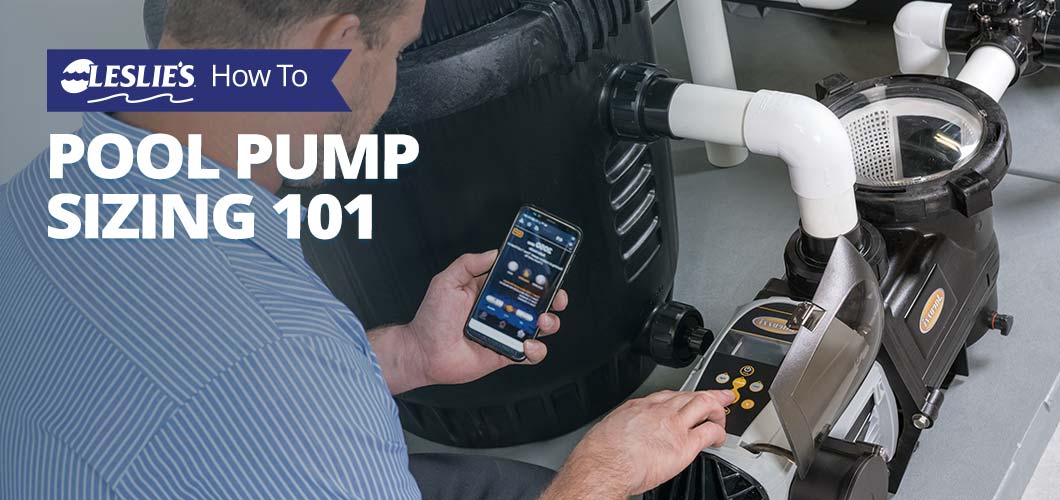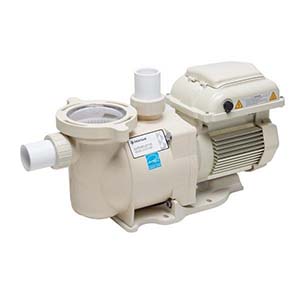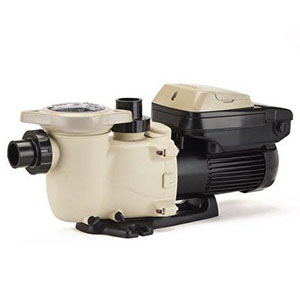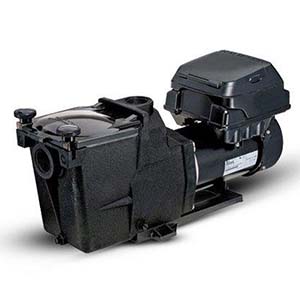
Pool Pump Sizing 101
If you’re reading this article, you’re probably in the market for a new pool pump. The most important part of any pool pump purchase is selecting the right size. Not only do you need a pump that can keep up with your pool volume, but you also don’t want to overpower your filter’s flow rate. With all the different pump models, styles, and horsepower ratings available, choosing the correct pump can be a daunting process. But fear not! With our helpful tips below, you can shop confidently for your new pool pump. We'll help you learn how to choose the right size of pump for your pool.
Highlights include:

Calculate Pool Volume

Determine Minimum Turnover Rate

Identify Filter Flow Rate

Consider Pump Workload and Efficiency
Step 1: Calculate Pool Volume
First things first; how many gallons of water are in your pool? If you don’t know off the top of your head, here are a few quick and easy calculations that will give you a close estimate.
For all these equations, your depth measurement is the average depth of the pool. If you have a pool with a flat, level floor, your average depth is the same throughout the pool. If you have a sloped inground pool with a shallow end and a deep end, measure the depth of both ends to find the average:
(Deep End + Shallow End) ÷ 2 = Average Depth
Rectangular or Square Pool
Length x Width x Depth x 7.5 = Pool Volume (Gallons)
Round or Circular Pool
3.14 × Radius2 × Depth x 7.5 = Pool Volume (Gallons)
Oval or Rounded Rectangle Pool
3.14 x Length x Width x 0.25 x Depth x 7.5 = Pool Volume (Gallons)
Kidney-Shaped Pool
With a kidney-shaped pool, measure the widest point at both ends to get your A and B width measurements. Then plug those measurements into the equation below:
(Width A + Width B) x Length x 0.45 x Depth x 7.5 = Pool Volume (Gallons)
Other Irregular Pool Shapes
If your pool doesn't match the above shapes, you can at least get an approximate volume with the following formula:
Length x Width x Depth x 5.9 = Pool Volume (Gallons)
BONUS TIP: Not a fan of math? No worries! Leslie's has a few quick reference charts to help you easily estimate the number of gallons in your pool. Head over to our blog post, How To Calculate Pool Volume.
Step 2: Determine the Minimum Turnover Rate
What is the turnover rate, and how does it relate to your new pool pump? In short, turnover rate is the amount of time it takes the pump to circulate all the pool’s water one time. The ideal turnover rate for most pools takes around 8-10 hours. To find your pool’s minimum required turnover rate, use the following equation:
Pool Volume ÷ Hours = Gallons per Hour (GPH) Turnover Rate
Or, if you need to know the Gallons per Minute (GPM) rating, divide the GPH rate by 60:
GPH Turnover Rate ÷ 60 = Gallons per Minute (GPM)
For example, let's say we have a 15,000-gallon pool. If we’re wanting a pump that can provide an 8-10 hour turnover, we'd need something rated for a minimum of 1,500-1,875 GPH or 25-31 GPM.
Keep in mind that the GPM rate for the pump will go down the farther the pump is from the pool. We’ll talk about this a little more in Step 4 when we talk about pump head.
Step 3: Identify Pool Filter Flow Rate
The next step is to find the flow rate of your current pool filter (or new filter, if you’re upgrading all your equipment at the same time). This one is especially important. A pump that’s too powerful for the filter won’t allow it to work efficiently. In most cases, an oversized pump can cause the motor to overheat or the filter to become damaged.
When choosing a pump to pair with a filter, the pump’s GPM rating should never exceed the filter’s maximum flow rate. If anything, the filter should be somewhat “oversized” for the pump and pool, so you’ll never run into flow rate or filtration efficiency issues. You can find flow rate information for the filter on the package or the affixed label.
BONUS TIP: At this point, you’re probably thinking, “OK, that’s all great, but how much horsepower do I need?” The horsepower of a pump motor is a common unit of measure that identifies the capabilities of your pump. However, it shouldn’t be a starting point in your search for a new pool pump. The most important aspect of sizing a pool pump involves the pump flow rate and how that relates to your pool size, filter flow rate, and plumbing size. Once you’ve narrowed down the list of pumps compatible with your system, you can use the different horsepower ratings to help you make your final decision. Higher horsepower ratings mean the pump can produce higher head pressure, which we'll talk about in the next section.
Step 4: Establish the Scope of Work for the Pool Pump
Will you need a high head or medium head pump? What size is your plumbing, and will you need a 1½” inlet and discharge or 2” inlet and discharge? Does the pump need to be self-priming, or will a non-self-priming pump do the job?
Medium Head vs. High Head Pumps
Medium head pumps are used when resistance in the system is low. An example of this would be a pool that only has an in-line filter (no heaters or in-line sanitation systems), and the equipment is relatively close to the pool with very few turns in the plumbing.
High head pumps are used when resistance in the system is high. An example of this would be a pool with a water feature, connected hot tub, solar heating, in-floor cleaning system, deck jets, therapy jets, a series of valves or turns in the plumbing, lots of in-line equipment, or an equipment pad that’s quite a distance away from the pool.
Pool Plumbing Size Considerations
There are numerous factors that can determine what size of PVC plumbing you will want to use in a pool pump application. A good rule of thumb is that medium head pumps can use 1½" PVC (maximum flow rate of 42 GPM), while high head pumps should be paired with 2" PVC (maximum flow rate of 73 GPM) or greater. Larger plumbing setups can tolerate higher flow rates. In all instances, the plumbing connections for your pump should never exceed the size of those on your filter.
Priming the Pump
Self-priming pumps are typically used when the body of water is lower than the equipment pad, as you would find for most inground pools. A self-priming pump can lower the atmospheric pressure inside the pump housing to draw the water from the pool into the pump.
BONUS TIP: The self-priming action of a pool pump is the same concept as if you were drinking from a straw. That said, the length of the straw (the distance from the pool to the pump) determines how hard it will be to draw liquid into the pump. This is called dynamic head pressure.
Non-self-priming pumps are typically used when the body of water is higher than the equipment pad, and is commonly reserved for above ground pools or spas. A non-self-priming pump is designed to be force fed with water, and it does not need modified functionality to draw water in.
Voltage Requirements
What are the voltage requirements for the pump, and is your pool’s equipment pad set up for it? Typically, inground pool pumps are wired for 208V-230V, and above ground pool pumps are wired for 115V. Some pumps are 115/230V, meaning they can be installed on either, depending on your needs.
Step 5: Consider Efficiency Standards
This one can save you quite a bit of money on your monthly utilities. Current federal efficiency standards require pool pumps greater than 1.0 THP to be variable speed pumps. What is THP? THP stands for Total Horsepower, and is a measure of the Horsepower (HP) multiplied by the Service Factor (SF), which is a measure of the pump’s working ability. The higher the Service Factor, the lower the efficiency, and the more energy lost to heat. Even if a single speed pump meets the minimum efficiency requirements, many pool owners opt to upgrade to a variable speed model instead.
Think of a variable speed pump like a car: if you drive at a consistent, moderate speed, you’ll maximize your fuel efficiency. On the other hand, let's use the car scenario with a single speed pump: if you constantly drive with the pedal to the metal, and you make lots of hard stops along the way, not only will you use up fuel quickly, but you'll also wear down your car faster. The same holds true for your pool pump! Aside from the energy savings, one of the biggest benefits of a variable speed pump is that they tend to last longer than their single speed counterparts.
Not convinced? Take a look at our variable speed pump energy savings calculator to see just how much money you could save each year. In most cases, upgrading from a single speed to a variable speed pump can pay for itself over 2-3 swimming seasons.
Step 6: Choose Your New Pool Pump
Now that you’re armed with all the necessary information, it’s time to choose your pool pump! The pump you choose should meet all criteria for minimum turnover rate, maximum flow rate, and any other requirements for your unique pool setup. Most manufacturers will have a chart showing the “feet of head” resistance pressure in relation to the flow rate and horsepower ratings to help you make your final decision.
If you’re still not sure which pump you need, we can help! Call or stop by your local Leslie’s store to speak with one of our knowledgeable pool experts. If you need help getting the new pump up and running, ask about Leslie’s installation services.


